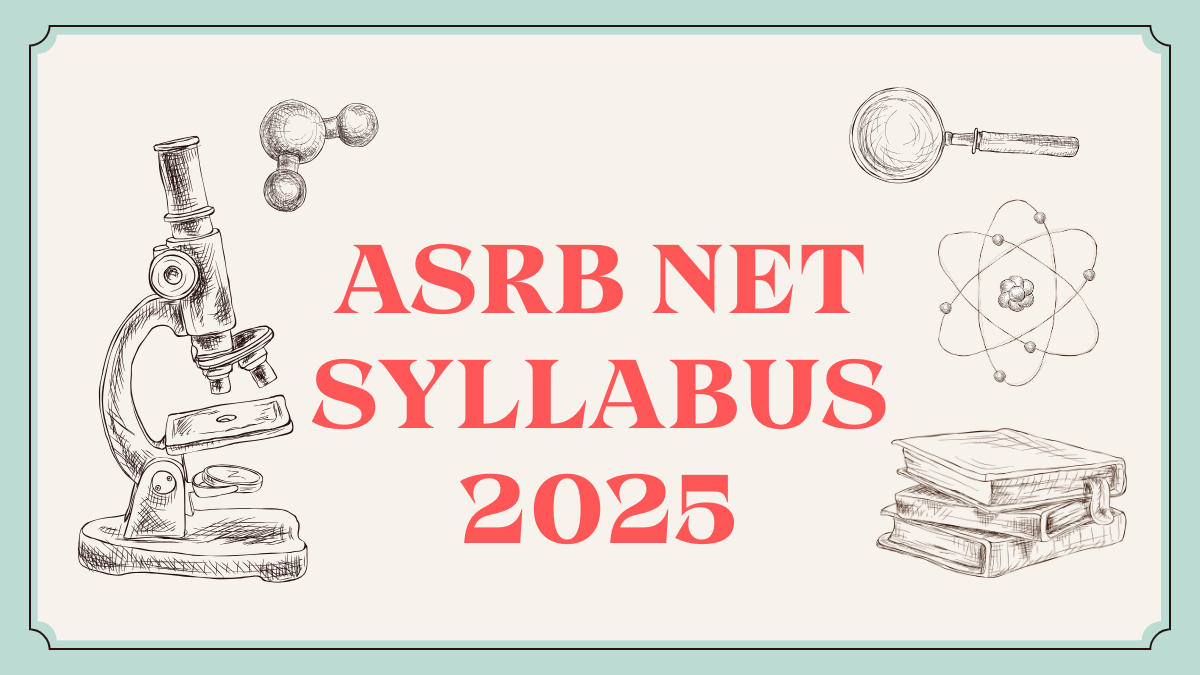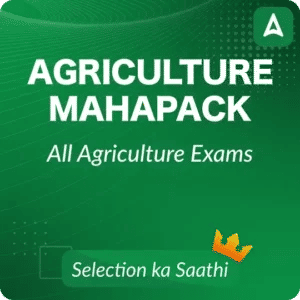ASRB NET Syllabus
|
| Subject |
Syllabus |
| Agricultural Biotechnology |
- Cell structure and function
- Biomolecules and metabolism
- Enzymology
- Molecular genetics
- Gene expression
- Molecular biology techniques
- Gene cloning
- Molecular biology
- Plant molecular biology
- Tissue culture
- Plant genetic engineering
|
| Agricultural Entomology |
- Systematics
- Morphology
- Embryology, internal anatomy and physiology
- Ecology
- Biological control
- Chemical control and toxicology
- Host plant resistance
- Innovative approaches in pest control
- Integrated pest management
- Pesticide application equipment
- Pests of field crops and their management
- Pests of horticultural crops and their management
- Pests of stored products and their management
- Arthropod vectors of plant diseases
- Honey bees and bee-keeping
- Silkworms and sericulture
- Lac insect
- Other useful insects
- Statistics and computer application
|
| Agricultural Microbiology |
- History of microbial world
- Microbial ecology and physiology
- Soil microbiology
- Environmental microbiology and basic microbiological techniques
- Microbial biotechnology
|
| Economic Botany & Plant Genetic Resources |
- Plant taxonomy and biosystematics
- Economically important plants-I
- Economically important plants-II
- Economically important plants-III
- Biodiversity and plant genetic resources
- Germplasm augmentation
- Germplasm conservation
- Biotechnology in PGR
- Plant quarantine
- Germplasm characterization, evaluation, maintenance and regeneration
|
| Genetics & Plant Breeding |
- General genetics and plant breeding
- Economics botany and plant breeding methods
- Genome organization and cytogenetics of crop plants
- Quantitative and biometrical geics
- Genetic engineering and biotechnology tools in plants breeding
- Plants breeding for stress resistance and nutritional quality
- Plant genetic resources and their regulatory system, varietal release and seed production
- Statistical methods and field plot techniques
|
| Nematology |
- History and economic importance
- Nematode taxonomy and morphology
- Nematological techniques
- Nematode ecology
- Plant nematode relationships
- Nematode physiology and cytology
- Nematode management
- Interactions of nematodes with soil organisms
- Statistics
|
| Plant Biochemistry |
- Basic biochemistry and biomolecules
- Intermediary metabolism
- Enzymes, vitamins and hormones
- Molecular biology
- Techniques in biochemistry
- Biochemistry of food-grains, fruits and vegetables
- Photosynthesis
- Plant metabolic processes
- Plant molecular biology
- Plant biotechnology/genetic engineering
|
| Plant Pathology |
- History and principles of plant pathology
- Laboratory and analytical techniques
- Physiological and molecular plant pathology
- Mycology
- Plant bacteriology
- Plant virology
- Plant disease epidemiology
- Phanerogamic parasites and non-parasitic diseases
- Fungal diseases of crop plants
- Bacterial and viral diseases of crop plants
- Management of plant diseases
|
| Plant Physiology |
- Cell organelles and water relations
- Metabolic processes and growth regulation
- Crop productivity and modelling
- Abiotic stress responses in plants
- Plant growth regulators and plant development
- Mineral nutrition
- Climate and climate change
- Seed physiology
- Physiology of flowering and reproduction
- Physiology of horticultural and plantation crop species
- Post-harvest physiology
- Morphogenesis, tissue culture and plant transformation
|
| Seed Science and Technology |
- Seed production
- Seed processing
- Seed quality control
- Seed storage
- Seed health
- Seed industry development and marketing protection of plant varieties
|
| Floriculture and Landscaping |
- Breeding
- Production technology of cut flowers
- Production technology for loose flowers
- Landscaping
- Protected floriculture
- Value addition
- Turfing and turf management
- Computer aided designing for outdoor and indoor escaping
|
| Fruit Science |
- Subtropical and temperate fruit production
- Biodiversity and conservation
- Canopy management in fruit crops
- Breeding of fruit crops
- Post-harvest technology
- Growth and development
- Protected fruit culture
|
| Spices, Plantation, Medical & Aromatic Plants |
- Production of plantation crops
- Production technology of spice crops
- Acronym of medicinal, aromatic and under-utilized crops
- Breeding of plantation crops and spices
- Breeding of medicinal and aromatic crops
- Processing of plantation crops, spices, medicinal and aromatic plants
- Organic spice and plantation crop production technology
|
| Vegetable Science |
- Production technology of cool season vegetable crops
- Production tech. of warm season vegetable crops
- Breeding of vegetable crops
- Growth and development
- Seed production
- Systematics of vegetable crops
- Production technology of underexploited vegetable crops
- Post-harvest technology of vegetable crops
|
| Animal Biochemistry |
- Scope of biochemistry and molecular biology in animal sciences
- Structure and properties of carbs and fats
- Aminoacids, structure and properties
- Major classes of enzymes
- Bioenergetics, biological oxidation, etc.
- Mechanism of storage, transmission and expression of genetic information
- Functions of water & lipid soluble vitamins
- Blood composition and biochemical constituents
- Basic principles and use of latest photometric, chromatographic, etc.
- Environmental pollution in relation to animal health
|
| Animal Biotechnology |
- Cell biology
- Molecular biology
- Gene structure and regulation of gene expression
- Genetic engineering and recombinant DNA technology
- Cell culture and hybridoma technology
- Reproductive biotechnology and related techniques
- Molecular biology techniques
|
| Animal Genetics and Breeding |
- Overview of geics
- Advanced geics
- Overview of breeding
- Genetic properties of population
- Population geics
- Genetic strategies
- Selection & selection experiments
- Genetic laboratory techniques
- Research techniques for quantitative animal genetics
- Laboratory animal breeding
|
| Animal Nutrition |
- Energy and proteins
- Minerals, vitamins and feed additives
- Rumen ecosystem and functions
- Non-ruminant nutrition
- Nutrient requirements
- Forage conservation and evaluation
- Feed processing and technology
- Ant-metabolites and toxic principles
- Elements of research methodology
- Clinical nutrition
|
| Animal Physiology |
- Cellular basis of animal physiology
- Blood and circulation
- Respiration
- Excretion
- Digestion
- Muscle physiology
- Nervous system
- Endocrinology
- Reproduction
- Physiology of growth
- Climate physiology
- Behavioural physiology
|
| Animal Reproduction and Gynaecology |
- Veterinary Gynaecology
- Reproductive Endocrinology
- Accident during gestation
- Veterinary obstetrics
- Andrology
- Male infertility
- Frozen semen technology and artificial insemination
- Reproductive technology
- Infertility in cows and buffaloes
- Reproduction and infertility in ovine/caprine
- Reproduction and infertility in swine
- Equine reproduction
- Canine and feline reduction
|
| Dairy Chemistry |
- Milk constituents, their physical and chemical nature
- Levels, distribution, isolation, and genetic polymorphism of different milk proteins
- Milk lipids, auto-oxidation, antioxidants cholesterol, fat, etc.
- Milk adulteration and deduction methods
- Cream, desi butter, ghee – properties
- Heat stability of milk
- Cheese: Composition & varietal differences
- Ice-cream: composition & physical structure
- Quality control & assurance
- Spectroscopy
|
| Dairy Microbiology |
- Microflora
- processing techniques like bactifugation, thermistation, etc.
- Naturally occurring preservatives
- Microbiological quality of fat rich products
- Lactic Acid Bacteria (LAB)
- Dairy products as functional/health foods
- Role of starters in preparation of fermented products
- Microbiological quality of indeginous dairy products
- Preparation of byproducts
- Quality control & assurance
|
| Dairy Technology |
- Market milk
- Fat rich dairy products
- Frozen milk products
- Cheese and fermented milk products
- Concentrated and dried milk products
- Indigenous milk products
- Utilization of milk by-products
- Packaging of milk and milk products
- Cleaning and sanitation
- Advances in dairy technology
- Legal and quality aspects for milk and milk products
|
| Livestock Products Technology |
- Basic and general aspects of livestock products
- Abattoir and poultry processing plants
- Processing and preservation
- Wool, mohair and fur
- Packaging
- Quality control
- Marketing
|
| Livestock Production and Management |
- General
- Breeding management
- Feeding management
- Reproduction management
- Shelter management
- Health management
- Production and management of cattle and buffalo
- Production and management of other animals
- Wildlife management
- Forage production and conservation
- Economics and marketing of livestock and poultry and their products
|
| Poultry Science |
- Poultry genetics and breeding
- Poultry nutrition
- Avian physiology
- Poultry products technology
- Poultry management
- Economics and marketing
- Poultry health management
|
| Veterinary Medicine |
- General medicine
- Diagnosis of animal diseases
- Gastroenterology
- Diseases of cardiovascular and pulmonary system
- Diseases of urinary, nervous, musculoskeletal and integumentary systems
- Production and deficiency diseases
- Common toxicities
- Infectious diseases
- Parasitic diseases
- Poultry diseases
- Veterinary jurisprudence and ethics
- Special therapeutic approaches
- Prevention and control of diseases
- Common diseases of zoo, laboratory animals and wildlife
|
| Veterinary Microbiology: |
- General bacteriology
- Systematic bacteriology
- General virology
- Systematic virology
- Mycology
- Immunology
- Molecular cell biology
|
| Veterinary Parasitology |
- Veterinary helminthology
- Veterinary entomology
- Clinical parasitology
- Parasitic zoonosis
- Management of livestock parasitism
- Immuno parasitology
- Diagnostic parasitology
|
| Veterinary Pathology |
- Introduction, history and etiology
- Haemodynamics derangements, degeneration and necrosis
- Inflammation and healing
- Immunopathology
- Genetically determined diseases
- Disturbances in cell growth and oncology
- Postmortem diagnosis and histopathological techniques
- Clinical pathology
- Systematic pathology
- Pathology of infectious diseases
- Avian pathology
- Nutritional and production pathology
- Pathology of toxicosis
- Pathology of diseases of laboratory and wild animals
|
| Veterinary Pharmacology |
- General pharmacology
- Drug acting on the central nervous system
- Drugs acting on the humerus and autonomic nervous systems
- Drugs acting on digestive system
- Drug action on urogenital system
- Endocrine pharmacology
- Autacoids
- Chemotherapy
- Toxicology
- Ecotoxicology
- Miscellaneous topics
|
| Veterinary Public Health |
- Veterinary public health
- Milk hygiene
- Meat hygiene
- Food-borne infections and intoxications
- Zoo-noses
- Environmental hygiene
- Epidemiology
- Experimental animal medicine
- Health education
- Standard guidelines and legislation
- Microbiology in public health
|
| Veterinary Surgery |
- General surgery
- Anaesthesia
- Radiology
- Orthopaedics and lameness
- Surgery of head and neck region
- Thoracic surgery
- Abdominal and pelvic surgery
|
| Aquaculture |
- Species selection criteria for various culture practices
- Broodstock development and management
- Farm design, construction and operational management
|
| Fisheries Resources |
- Fisheries resources
- Fishery biology
- Aquatic environment
- Fisheries management
- Fishing technology
- Economics and marketing
- Fisheries livelihood
|
| Fish Processing Technology |
- Craft technology
- Gear technology
- Process biochemistry
- Fish processing technology
- Microbiology, quality management and certification
- Fishery engineering
- Economics and marketing
|
| Fish Nutrition |
- Principle of fish nutrition
- Nutritional physiology
- Feed formulation, feed technology and feeding management
- Nutrition and fish health
- Nutrigenomics
|
| Fish Health |
- Introduction to fish health and pathology
- Diseases of fish
- Aquatic environment and fish health
- Diseases diagnosis
- Defence systems and tumours
- Diseases prevention and control
|
| Fish Genetics & Breeding |
- Principles of fish genetics and breeding
- Population and quantitative geics
- Genetics tools for aquaculture application
- Breeding of fish and shellfish
- Conservation, bioinformatics
|
| Agricultural Chemicals |
- General chemistry
- Chromatography and spectroscopic techniques
- Chemistry of natural products
- Naturally occurring insecticides
- Synthetic insecticides, fungicides, nematicides and rodenticides
- Herbicides and plant growth regulators
- Agrochemical formulations
- Pesticide residues and their dynamics in the environment
- Agrochemicals-regulation and quality control
- Natural resource management
- Environment pollution: implications and remediation
- Data analysis
|
| Agricultural Meteorology |
- General climatology
- Agricultural climatology
- Micro-meteorology
- Evapotranspiration
- Crop weather modelling
- Weather forecasting for agriculture
|
| Agroforestry |
- Forestry policies and acts
- Agroforestry, Social Forestry, Community Forestry, Farm Forestry
- Plant Management
- Extent and causes of land denudation
- Forest mensuration
- Silviculture
- Seed collection, processing, storage, etc.
- Forest Management
- Tree improvement
- Global overview of Agroforestry
- Measurement of trees and stand
- Climate change
- Statistics
|
| Agronomy |
- Crop ecology and geography
- Weed management
- Soil fertility and fertilizer use
- Dryland agronomy
- Crop production in problem soils
- Crop production
- Agricultural statistics
- Sustainable land use systems
- Basics of soil and water
- Soil water relationship
- Plant water relationship
- Irrigation water management
- Management of problematic soils and water
|
| Environmental Science |
- Definition and scope of environment science
- Basic ecological concepts
- Biodiversity concepts
- Composition of air
- Soil and water pollution
- Climate Change
- Energy consumption in urban and rural India
- Natural resources of India
- Frequency distribution, mean, median, mode and standard deviation
|
| Soil Science |
- Pedology
- Soil physics
- Soil chemistry
- Soil fertility
- Soil microbiology
- Statistics
|
| Agri-Business Management |
- General management
- Business accounting & financial management
- Marketing management
- Management economics and farm management
- Quantitative techniques
- Strategic management and entrepreneurship
|
| Agriculture Economics |
- Economic theory
- Agricultural development and policy
- Natural resource and production economics
- Agricultural finance and project management
- Agricultural marketing and price analysis
- Operations research methods
|
| Agricultural Extension |
- Fundamentals of extension and communication
- Extension methods & farm journalism
- Information communication technologies
- Training & human resource development
- Research methodology in extension education
- Programme planning, evaluation & diffusion and adoption of innovations
- Extension management
- Entrepreneurial development
- Developmental strategies and issues in extension
- Gender sensitize and empowerment
|
| Agricultural Statistics & Informatics |
- Mathematical methods in statistics
- Probability and mathematical statistics
- Statistical inference
- Applied multivariate analysis
- Design of experiments
- Sample surveys
- Statistical geics
- Applied regression analysis
- Optimization techniques and soft computing
|
| Home Science |
- Human nutrition, health and interventions
- Food science and processing technologies
- Textile science, fashion designing and garment production
- Human development and family dynamics
- Family resource management and consumer science
- Home science extension and communication methods
|
| Farm Machinery and Power |
- Farm mechanization and equipment
- Farm machinery design
- Farm machinery testing evaluation and management
- Engines and tractor systems
- Ergonomics and safety
- Soil dynamics in tillage and traction
- Energy in agriculture
- Manufacturing technology
- Instrumentation and measurement techniques
|
| Computer Application & IT |
- Computer organization and architecture
- Programming language & data structure
- Software engineering
- working & operation system
- Compiler construction
- Database management system
- Computer graphics
- Artificial intelligence and soft computing
- Statistics modelling and simulation
- Bioinformatics
|
| Land and Water Management Engineering |
- Ground water development wells and pumps
- Open channel hydraulics
- Soil, plant, water and atmosphere relationship
- Hydrology and soil and water conservation
- Watershed management
- Irrigation water management
- Management of degraded, waterlogged and other problematic soils and water
|
| Bioinformatics |
- Programming languages
- Database systems and biological databases
- Mathematics and statistics
- Biochemistry and molecular biology
- Genomics and proteomics
- Analytic bioinformatics
- Molecular modelling
- Algorithms and data structures in bioinformatics
|
| Food Technology |
- Introductory food technology
- Technology of foods of plant origin
- Technology of foods of animal origin
- Food quality management
- Food engineering/packaging and labelling
- Food microbiology & biotechnology
- Flavour chemistry technology
- Consumer sciences/food product development/health foods
|
| Agricultural Process Engineering |
- Heat and mass transfer
- Farm structures and farmstead planning
- Storage engineering
- Material handling packaging and transport
- Post-harvest operations
- Processing technology and processing equipment design
- Engineering properties & quality of bio-materials
- Agri-project planning and management
- Aquaculture processing technology & structures design
- Dairy engineering, instrumentation and process control
|
| Veterinary Anatomy |
- Gross Anatomy
- Micro Anatomy
- Developmental Anatomy
|





 RPSC Agriculture Officer Admit Card 2025...
RPSC Agriculture Officer Admit Card 2025...
 BSSC Field Assistant Recruitment 2025 No...
BSSC Field Assistant Recruitment 2025 No...
 UP Police SI Syllabus 2025 And Exam Patt...
UP Police SI Syllabus 2025 And Exam Patt...


 Adda247 Job portal has complete information about all Sarkari Jobs and Naukri Alerts, its latest recruitment notifications, from all state and national level jobs and their updates.
Adda247 Job portal has complete information about all Sarkari Jobs and Naukri Alerts, its latest recruitment notifications, from all state and national level jobs and their updates.